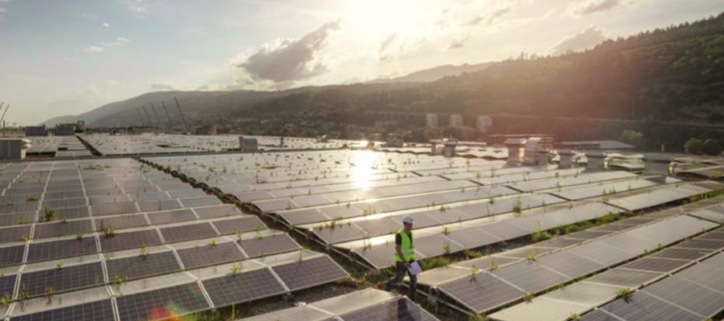Renewables generate opportunities
Allen Austin
Market Development Manager – Renewable Energy & Power Generation
ABB Electrification Business
Both residential and commercial customers are increasingly turning to renewable energy sources that’s creating huge demand for energy storage systems. Panel shops should be looking at how they can be part of this growth.
You keep your fridge stocked with food. You have gas in the tank of your SUV and maybe a can or two in the garage. You have spare rolls of toilet paper in the hall closet. Everyone stores supplies of these essentials on hand. But until relatively recently, there’s one essential that simply couldn’t be stored: electric power.
That situation, however is changing, and changing rapidly. And that’s creating big opportunities for panel builders. A March 9, 2019 greentechmedia.com article was headlined “US Energy Storage Broke Records in 2018, but the Best Is Yet to Come.” As one strong example, the article stated that the solar industry is expected to double in 2019 and triple in 2020.
Continued growth in renewables generate opportunities for panel builders
The remarkable growth of renewable power generation is driving demand for energy storage systems at every level. Much of it is at utility scale, but there’s also been a boom in the smaller commercial and residential installations. During 2018, these smaller storage systems collectively outperformed utility-scale deployments for four quarters in terms of megawatts. Panel builders looking to expand their business should be looking with great interest at filling the market demand for safety and control panels for these energy storage systems.
The technology needed to create panels for energy storage has matured greatly in the last few years. The required panel components – circuit breakers, switch disconnectors, contactors, and fuse holders – are readily available from a number of OEMs. Designing and producing panels for energy storage applications is relatively straightforward. All panel builders need is an interest in expanding into this growing niche and a trusted supplier to provide the needed components and technical support.
That supplier is likely to recommend that your panel incorporate 1,500 VDC components.
Benefits of 1,500 VDC
Early protection and control systems for renewable energy operated at 600 VDC. In 2013, US standards began to evolve to allow the higher-voltage 1,000 VDC technology that was the standard in Europe. US-based system designers and developers eagerly began to transition so they could capitalize on the significant cost reductions delivered by the 1,000 VDC technology.
Operating at the higher voltage creates end-to-end efficiency improvements. Line losses are lower, construction costs are smaller, and the number of components and related cabling is reduced. Instead of using two circuit breakers, one on each of two 600 VDC lines, they could use a single breaker on a 1,000 VDC line. Shifting to the higher voltage typically reduced solar deployment costs by more than 25%.
The higher-voltage 1,000 VDC-rated balance-of-system (BOS) equipment came at a slightly higher cost than the comparable 600 VDC devices, but the resulting system-wide cost savings more than made up the difference. Seeing the impressive efficiency gains and lower cost per kilowatt hour drove device makers to continue to push the envelope further. In 2014, the first two 1,500 VDC pilot projects went online.
From a cabling and panel-design standpoint, the main concern created by the higher voltages is the need for increased conductor spacing. Devices become larger and internal arcing becomes a greater concern. Still, the approximately 25% reduction in installation costs and 35% operating efficiency gains has made 1,500 VDC systems the new normal.
The Right Partner
How renewables generate opportunities for panel builders – while jumping into the energy-storage market isn’t a huge leap for most panel makers, it’s still not a jump you want to take on your own. Electricity is electricity, but there are some unique aspects to energy storage systems and certain expectations from the system developers/builders.
To make sure your first steps are taken in the right direction, carefully consider the suppliers for your panel components. There’s a long list of familiar names able to supply you with some or all of the devices you’ll need. But many of them, eager to be part of the boom in 1,500 VDC energy storage market, offer me-too products based on someone else’s design. Look beyond whether they simply have the components in their catalog. Do they have a deeper understanding of the energy storage market and how the components work in the overall system?
Also consider whether they can provide the full line of 1,500 VDC devices needed to build out your panels. Panel makers looking to minimize costs commonly source components from a number of suppliers, and have complete confidence the components will integrate without problems. That’s a safe bet for familiar applications and panel designs. However, a higher level of caution and more careful consideration of your supplier might be appropriate for your first energy storage panels.
Relying on a single supplier who can provide all the components you need will give you a higher level of confidence that your first energy storage panel will be problem free. Not only can you be sure that the components will integrate without problems, your full-line supplier is more likely to have experience with energy storage components and system design. A trusted partner like that will ensure that your entry into this market will be successful.
Summary
Indications are that energy storage will be a red-hot market for at least the next few years, with no indication it will level off anytime soon. Panel shops interested in expansion should be exploring if and how they can take advantage of this opportunity.
While exploring this market – and how you might share in its growth – also carefully explore and vet your potential suppliers for the required 1,500 VDC components. Choosing a capable and qualified supplier will ensure problem-free panels and a brighter, renewable-energy-powered profitability picture for your shop.
Recommended resource: Energy storage solution kit




